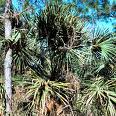Cabbage Palmetto Tree Information
Images of Cabbage Palmetto:






Cabbage Palmetto grows in the following 4 states and provinces:
Florida, Georgia, Hawaii, South CarolinaInformation about Cabbage Palmetto:
as well ashe Sabal Palmetto is commonly known as the Cabbage Palmetto.
The currently accepted scientific name for cabbage palmetto is Sabel palmetto (Walt.) Lodd. (Arecaceae). There are no infrataxa .Cabbage palmetto grows throughout peninsular Florida and the Florida Keys. It grows in the coastal areas of the Florida panhandle, Georgia, and South Carolina . It is cultivated in Hawaii . Outside of the United States, cabbage palmetto occurs in the Bahamas and Cuba .In southern Florida, cabbage palmetto is a common component of high and low hammock, tree island, and mixed conifer-hardwood swamp communities . Elsewhere it grows in more xeric scrub and Miami rock-ridge inland communities . In the Florida Panhandle, Georgia, and South Carolina, cabbage palmetto grows within 12 miles (20 km) of the coast. It is a componenet of several diverse plant communities, including those characteristic of dunes, salt flats, barrier islands, and cactus thickets . Associates are many and varied because of the diversity of Florida's flora and the ecological amplitude of cabbage palmetto. Overstory associates include south Florida slash pine (Pinus elliottii var. densa), slash pine (P. elliottii var. elliottii), pond pine (P. serotina), loblolly pine (P. taeda), longleaf pine (P. palustris), eastern redcedar (Juniperus virginiana), various evergreen oaks (Quercus spp.), loblolly-bay (Gordonia lasianthus), red bay (Persea borbonia), magnolia (Magnolia spp.), sweetgum (Liquidambar styraciflua), red maple (Acer rubrum), baldcypress (Taxodium spp.), pignut hickory (Carya glabra), gumbo-limbo (Bursera simaruba), and cocoplum (Chrysobalanus icaco). Understory associates include gallberry (Ilex glabra), huckleberries (Gaylussacia spp.), blueberries (Vaccinium spp.), lyonias (Lyonia spp.), southern bayberry (Merica cerifera), holly (Ilex spp.), saw-palmetto (Serenoa repens), greenbriar (Smilax spp.), bracken fern (Pteridium spp.), poison-ivy (Toxicodendron radicans), bluestem (Andropogon spp.), sawgrass (Cladium jamaicensis), and beak rush (Rhynchospora spp.). Exotic associates and probable competitors include casuarina (Casuarina spp.), melaleuca (Melaleuca quinquenervia), coconut (Cocos nucifera), and Brazilian peppertree (Schinus terebinthifolia).Some of the information provided here is attributed to:Van Deelen, Timothy R. 1991. Sabal palmetto. In: Fire Effects Information System, [Online]. U.S. Department of Agriculture, Forest Service, Rocky Mountain Research Station, Fire Sciences Laboratory (Producer). , available at the USDA Fire Effects Information System (FEIS) website